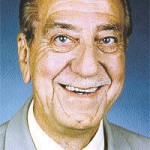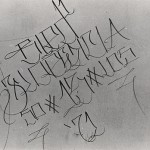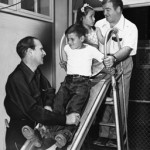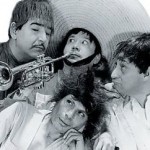
Ajua! Someone has correctly answered all of the questions on the
ARE YOU SMARTER THAN AN EASTSIDER? Quiz!
One very Eastside Culture savvy contestant has demonstrated a profound
knowledge of all things Eastside, and has proven to be truly deserving of the Grand Prize! A certificate good for Dinner for Two from:
EL CONQUISTADOR RESTAURANT in Silver Lake!
(I wanted the prize to be a trip far away from THE EASTSIDE so I picked the very self-proclaimed hip Westside town of Silver Lake!) Que Gácho! Anyway, here are the answers to the quiz:

(1) Identify this East Los Personality
Some WRONG answers that were submitted:
•   Ed Roybal
•   El Matador Carabello
•   El Chavo
The Correct Answer is: DICK HUGG (HUGGY BOY)
(1)   What Eastside Park did Charlie Chaplin use for his film “His Trysting Place�
The Correct Answer is: HOLLENBECK PARK
(2)Â Â Â Name 5 Eastside Car Clubs (past or present) Some answers given: LIFESTYLE, IMPERIALS, BROWN STYLE, KLIQUE, MANIACOS, Good Times, Viejitos, The Dukes, Chicano Style Car Club, The Lady Bugs, Old Memories, Saints (El Sereno 50’s), ELA Auto Butchers. Phantoms (Lincoln Hts 1950’s)
(3)Â Â Â Name 3 Movies that have to do with East L.A. and Cholos
Some answers given: American Me, Bound by Honor, Boulevard Nights, Crash, Up in Smoke, Blood in Blood out, Zoot Suit, Boulevard Nights,
Mi Vida Loca? (OH NO YOU DIDN’T!!! I SAID EAST L.A.! -Al) Mi Familia, Colors, Born In East L.A.
(4)Â Â Â Decipher This: Answer: Bird from Florencia 13 (aka F 13, Florence 13), #1, So Los aka South Central LA
Answer: Bird from Florencia 13 (aka F 13, Florence 13), #1, So Los aka South Central LA
(5)Â Â Â What Street is this photo taken on?  Correct Answer: BROOKLYN AVENUE
Correct Answer: BROOKLYN AVENUE

(6)Â Â Â This nice Jewish boy from Brooklyn, N.Y. came to Boyle Heights with his family around 1916 where his family opened a grocery & drug store on Brooklyn Avenue. He soon moved on to bigger & better things. He was investigated by the U.S. Senate in 1950. Correct Answer: MICKEY COHEN

(7)   Name That Pan Dulce: (Sorry, the answer: “All I know is Cuernos and Conchasâ€..is not correct) THE CORRECT ANSWER IS: Concha, Cuernito, Rol de Canela, Rol de Fresa, Cochinito, birote or bolillo. (Nobody named the Jelly Roll as: Niño Envuelto!)
(9) What Eastside Youth Recreational Center are these men dedicating? Correct Answer: Lou Costello Recreational Center on Olympic & Grande Vista near the Estrada Courts PJs. (That’s Abbott & Costello!)
(10) Name That Tune! Correct Answer: LA RASPA BY PEREZ PRADO
Bonus Question: Answer: LOS XOCHIMILCAS! Performing LA BANDA BORRACHA and QUE SE MUERAN LOS FEOS. (Wrong Answers: Los Polivoces or Cannibal & The Headhunters-Sorry!)
And the Big Winner is……………………………..
DON QUIXOTE!!!!!!!!!!!!!!! Who answered all 10 Questions correctly! A true Master of Eastside Trivia! Mr. Quixote , please accept your prize and submit a comment here to tell us how you became such a great scholar of Eastsideology!



#7 – there’s definitely a Novia (unless you are trying to name it rol de canela) and a Mantecada that was not mentioned
True; I went with most items correctly named.
I know that jelly roll as an ‘Ojo de Buey’ for the record. And I wish I looked like Huggy Boy, that guy looks young and spry!
That’s a sema (or is it cema?) on the left side, by the cuerno & concha… my favorite pan dulce b/c i fool myself into thinking its healthy-ish 😉
YOU LIKE ME! YOU REALLY LIKE ME! (Apologies to Sally “Ms Boniva” Field, by the way I always wonder why the Viagra people didn’t come up with that name first?).
In accepting this tremendous award from the irrepressible Al Desmadre I would like to thank not only Al but mis Abuelo’s who landed on the LA Eastside many years ago (shit it could have been Fresno or Brawly!), mis Jefe’s (for not being so upwardly mobile thereby guarantying my being a Lincoln Heights varrio vato loco), the LA Chamber of Commerce and the Powers that Be (for insuring all us raza were Varrio-ized and gerrymandered into powerless Eastside Chicano’s for a century or so), Dick “Huggy Boy” Hugg who played all those fine oldies rola’s for us Eastside Chicano’s and who we saw many times at the old El Monte Legion Stadium and Flash Record Store on Jefferson, where he broadcast his radio show from.
To our constant companion Comadre Sebastiana who has allowed me to live as long as I have without taking the fatal blow from her cold bony hands and death scythe, thereby enabling me to retain all this Eastside information, along with most of my marbles.
And to one of my hero’s, a character from the old Mexican folk story, Macario, who as a poor hungry dude found a turkey and decided to eat it all by himself.
But when he had it all cooked up and ready to eat who appears but Christ himself asking to share the meal.
Macario turns him down flat because Christ only rewards the righteous and allows the poor to suffer.
Then right before Macario is ready to dig in who shows up but El Diablo, who also wants some turkey in exchange for granting powers. No dice says Macario because the devil never did shit for him either except try to scam his soul through evil deeds.
Then just when it seemed the coast was clear and the turkey was hot and ready, Death himself appears and asks for a drumstick. This time though Macario shares his meal because in his mind Death treats all of us as equals when he comes a calling.
But don’t worry about me at dinner at the El Conquistador, because Al has graciously given me two dinners for the win.
A Sus Pies,
Yours Truly,
don quixote from the LA Eastside
DQ: Ignacio Lopez Tarso was great….
http://uk.youtube.com/watch?v=wPEU3n_BpP8
http://uk.youtube.com/watch?v=4u9S6PrLyNs&feature=related
Thanks Urbanista, Lopez Tarso was great, as was the Golden Age of Cinema in Mexico at that time.
What happened?
It turned into movies like: “los verduleros”, and bad shootout movies with los hermanos Almada.
Macario is originally a short story by one of my favorite authors, B. Traven.
I just met a visiting professor from Europe who actually studies all those bad shootout, narco, low budget movies from Mexico and the border region. I took her to Mercadito and she knew most of the movies on display. I was very impressed.
Chavo, ojo de buey are the round ones that look like pink snowballs with jelly in the middle. I wish someone would make a guide to pan dulce. When I was in Oaxaca they laughed at me when I asked the price of the “elotes.” I guess they have another pan that looks similar.
DQ, your acceptance speech wins reader comment of the week!
Also, my dad said during the 50s there was a very intimidating car club in Boyle Heights called the “SS.” Pretty fucked up considering there was still lots of Jews still living in the area at the time. Not sure if the car club members knew the significance. My dad says they didn’t.
Chimatli – in defense of the car club, it could have been “los eses”
Al – can’t forget “Los Albañiles” and “Risa en Vacaciones, 1 – 30 something”
DQ: I think the recent movie, La Ley de Herodes was great but was censored in Mexico by no other but the President Zedillo. http://www.youtube.com/watch?v=hDaxX8ZEQHk&feature=related
Thank you Chimatli, B Traven is one of my favorite authors and a very mysterious figure himself. Although Traven is credited by many for the story of Macario, his is actually an adaptation from an ancient folktale that may even have it’s roots in pre new world Spain.
It is to be found in Mexico and New Mexico oral folktales going back at least hundreds of years.
My own Grandmother told us kids this story of Macario the poor woodcutter, and she told us that her own Grandmother told it to her as a child.
But the film adaptation was brilliant.
And as Urbanista, Al, myself and you Chimatli, all lament the loss of the great film legacy in Mexico and wonder about all the reasons for this I’ll give you one good reason. I came accross this film history review from “Steve Seid†Curator , Berkeley Art Museum & Pacific Film Archives, University of California.
“Gabriel Figueroa was more than a cinematographer. A consummate artist, he captured with grandeur a sense of Mexico that would, as the poet Carlos Fuentes affectionately observed, bring us to “see Figueroa’s Mexico and not the one that really existed.†Beginning in the Golden Age of Mexican cinema, Figueroa’s rich chiaroscuro embodied Mexico’s entrenched contrasts—the monumental faces weathered like the arid land, the expressively lit cathedrals dark against turbulent skies, the timeless agave, stark and prickly. The painters Rivera, Siqueiros, and Orozco were Figueroa’s intimates, and their influence can be detected in what Siqueiros called “murals that travel.†Figueroa was the man who made manifest Luis Buñuel’s sardonic surrealism by underscoring mundane but unexpected details. And he will forever be associated with director Emilio “El Indio†Fernández, who said with remarkable swagger, “There only exists one Mexico: the one I inventedâ€â€”but it was Figueroa’s highly dramatic feel for the land that engendered this invention. In the mid-thirties, Figueroa apprenticed to Hollywood cinematographer Gregg Toland, and was much admired by American directors such as John Ford and John Huston, who used his signature style to great effect. He cut a dashing figure across the film industry, but his social conscience always preceded him: Gabriel Figueroa’s aim was to give back to Mexican culture a dignified image of itself, and this he did, a lo grande.â€
Where are these figures in Mexico nowadays?
Gabriel Figueroa’s cinematic visions were as great as his landscapes. The images of the great Mexican actors (and I emphasize the word ACTORS) such as Maria Felix, Ignacio Lopez Tarzo, Pedro Armendariz, Emilio Fernandez and the Soler Family were larger than life. You had fabulous screenplays (La Perla based on a Steinbeck novel)
and directors like the brilliant Luis Bunuel (Los Olvidados) who brought hints of his surrealist style to an era of Mexican cinema verite’. One reason for the decline was American investors in the Mexican ( late 40s-50s) film industry who got a hold of studios like Churubusco and imposed all sorts of budget restraints on mexican film production which resulted in low quality films called: “CHURROS”. The American investor ( his name was Jenkins) who was now controlling most of the production and theaters in Mexico was working towards a bottom line of exhibiting more & more American films from the U.S. in Mexico. These were all factors that led the classic Mexican Cinema to it’s decline. There’s been a refreshing resurgence of good films from Mexico in the past years. I hope it continues.
Goddamn it, you people made me buy Macario. I caught it on TV some time ago and never learned its name. Thanks!
I looked up the plot of Macario and found that I had heard a good chunk of it (Death at head/foot of bed) in a Llorona tale from New Mexico I read.
Anywho, I bought it and it should get to me by Christmas! w00t!
Thanks for expounding on the great Figueroa Al.
And it’s been many years since I have seen the classic movie La Perla or read the great Steinbeck novel “The Pearl”. I am going to have to rent that movie to see again.
One thing that has stayed with me are the scene’s of the Indio’s the rich guy brought in to track down Pedro Armendariz,Maria Felix, and their little baby.
The great photography of Figueroa showing those Tarahumara’s or Apaches or Yaquis around the campfire at night and tracking down Armendariz and family left an everlasting impression with me.
The cinematography of Figueroa, the direction of EL Indio Fernandez, a screenplay that Steinbeck himself worked on, and stellar performances by Pedro Almendariz and Maria Elena Marques all come together as Golden Age Mexican Cinema magic!
I recommend LA PERLA to everyone.